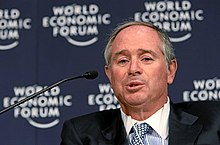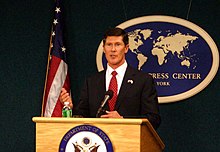Among the good ol’ boys club of high-profile CEO’s, excess and frivolousness just seem to come with the territory. But these ten CEOs have become particularly infamous for their gregarious, flamboyant lifestyles, and egotistical flights of fancy. They’re livin’ XXXL – often at the astronomical expense of the companies in their charge.
1.Dennis Kozlowski
Tyco CEO, Dennis Kozlowski was well known for his extravagant lifestyle. He reportedly had the company pay for his $30 million New York City apartment which included $6,000 shower curtains and $15,000 dog umbrella stands. In a more brazen move, Kozlowski billed Tyco $1 million for the 40th birthday party of his wife, by trying to disguise the party as a shareholder meeting. The extravagant bash, held on the Italian island of Sardinia, featured an ice sculpture of Michelangelo’s David urinating Stolichnaya vodka and a private concert by Jimmy Buffett.
In the end, Kozlowski left Tyco in 2002, while controversy stirred surrounding his compensation package. Kozlowski was later convicted in 2005 of crimes related to his receipt of $81 million in purportedly unauthorized bonuses, the purchase of art for $14.725 million and the payment by Tyco of a $20 million investment banking fee to Frank Walsh, a former Tyco director. Steve Schwarzman
2. Steve Schwarzman
Steve Schwarzman, the notoriously larger than life billionaire, is the co-founder and CEO of the private equity firm Blackstone Group. Much of Schwarzman’s wealth came from the use of cheap debt to leverage the buyouts and hostile takeovers of countless struggling companies. In 2007, Blackstone announced plans for an IPO, and many failed to appreciate that the deal was a bit too good to be true. In their rush to capitalize on Blackstone’s average 23 percent annual return, many investors overlooked the fact that the company being offered was a spinoff of the Blackstone Group, called Blackstone Holdings. Though the company was valued at $40 billion, Blackstone Holdings only had revenues of $2.3 billion a year.

Infamously narcissistic, for his 60th birthday party, the “King of Wall Street” threw himself multi-million dollar party featuring Martin Short, Rod Stewart and Patti LaBelle leading a church choir singing “He’s Got the Whole World in His Hands.”
3. Jimmy Cayne
As the financial markets began to go sour, and global investment firm Bear Stearns was on the verge of a total collapse, CEO Jimmy Cayne was leaving the office by helicopter for extended golf weekends. An avid bridge player, he was regularly out of town for tournaments and it is alleged that he smoked marijuana. Cayne was out playing bridge when two Bear Stearns hedge funds collapsed in July 2007, and was again the following March when the value of nearly $40 billion in high-risk mortgage bonds simply evaporated. This quickly prompted an emergency buy-out of Bear Stearns to J.P. Morgan at a fire sale price- reportedly less than the value of its office building.
4. Dick Fuld
Dick Fuld, the former CEO of Lehman Brothers, has the distinction of driving one of the most iconic investment banks and a Wall Street darling into the largest bankruptcy in U.S. history with some $613 billion in debts outstanding. Many credit Lehman’s demise to Fuld’s rampant risk-taking and his incredulous denial that the firm was serious in trouble- which some say prevented him from taking the steps necessary to save it. Moreover, from 2000 to 2007, Fuld allegedly cashed in on over $500 million in compensation.

5. Peter Kraus
After leaving Goldman Sachs in March 2008, Peter Kraus leveraged a stipulation he put into his employment contract at Merrill Lynch to collect a cool $25 million for only a three months of work before taking his current job as chairman and CEO of AllianceBernstein. The sweet deal, which came about when the Bank of America purchased the troubled Wall Street bank, was only discovered when he later bought a swank, five-bedroom apartment at 720 Park Avenue for almost $37 million. Rumor has it that his split from BofA was in part related to his egotistical and flashy behavior.
6. John Thain
John Thain, the CEO of Merrill Lynch, lead the company to $15 billion loss in the fourth quarter of 2009. But you never would guess it from the way he appropriated corporate funds. As his company was preparing to eliminate jobs and reduce business interests, Thain spent $1.22 million in early 2008 to “renovate two conference rooms, a reception area, and his office, spending $131,000 for area rugs, $68,000 for an antique credenza, $87,000 for guest chairs, $35,115 for a gold-plated commode on legs, and $1,100 for a wastebasket.”* He also pushed through nearly $4 billion in bonus payments to employees at Merrill in December 2008, rather than waiting until January, just as the company was being taken over by Bank of America.

Less than a week later, Kenneth Lewis, the CEO of Bank of America, pushed Thain out the door.
7. Lloyd Blankfein
In November 2009, London Times reporter John Arlidge conducted an exclusive interview with Lloyd Blankfein, CEO of the investment firm everyone loves to hate, Goldman Sachs. Goldman had agreed to the interview in an attempt to restore the investment bank’s tarnished image after a country dogged by high unemployment, home foreclosures, and tighten credit, watched the bailed-out bank ride out the recession unscathed while handing out mind boggling bonuses. Among the list of self-platitudes, the gregarious CEO affirmed that Goldman has a “social purpose” that “everybody should be, frankly, happy [about the bank’s success],” and that he’s “doing God’s work.” He later said he meant it as a joke.
Whether or not that’s true, his salary is certainly no joke. Blankfein is one of the highest paid executives on Wall Street and in 2010, received a bonus of $27.3 million, along with his salary, as well as, stock and options for a grand total of $53,965,418 in compensation for the year. In 2011, as the firm’s stock and profit fell. Goldman Sachs awarded Blankfein $12.4 million in total compensation.
8. Henry T. Nicholas III
Henry T. Nicholas III has definitely had a colorful laundry list of allegations thrown at him. Several years ago, the co-founder of semiconductor maker Broadcom Corp. was charged in court with not paying former employees, conducting securities and wire fraud, filing false statements to the Securities and Exchange Commission, and conspiracy to distribute illegal drugs. He also was accused of building an illegal underground network of tunnels and rooms at his Laguna Hills estate to indulge in drugs and prostitutes.

9. Bob Nardelli
Bob Nardelli was fired from his position of CEO at Home Depot six years after taking the helm. Throughout his tenure, as the home improvement company began to lose market share, Nardelli was busy alienating executives, downplaying customer service, and refusing to cut his bloated pay package. Since he was hired, Nardelli received a total of more than $240 million in salary, bonuses and stock grants. Nardelli’s Home Depot exit package of $210 million was regarded as one of the largest of all time. He was later hired by the private equity group Cerberus to turn around its struggling Chrysler unit. There, he took billions in government funds, only to be again shoved out the door two years later as the company came out of bankruptcy.
10. Angello Mozilo
From his simple beginnings as the son of a butcher, Angello Mozilo rose up to co-found Countrywide Financial in 1969 and turned it into the largest mortgage lender in America. But much of the company’s later success came with its adoption of exotic mortgage packages aimed at risky subprime borrowers- many of whom possessed questionable ability to repay these loans. As the credit markets went bust and the housing sector quickly followed, Countrywide Financial toppled and was eventually bought out by the Bank of America. But all of this didn’t stop Mozilo from filling his own coffers. The Wall Street Journal lists him as one the decade’s top 25 earners (he comes in at number 6) with a total compensation of almost $530 million dollars.
